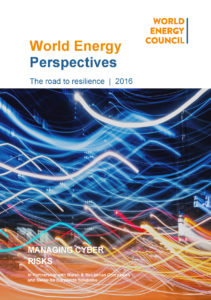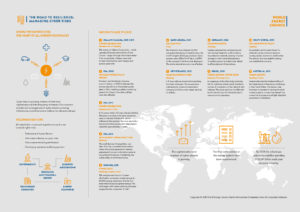
The report ‘The road to resilience: managing cyber risks’, published by the Council in collaboration with Swiss Re Corporate Solutions and Marsh & McLennan Companies, was launched at the Energy Day in Berlin, Germany, on 29 September. The report investigates how cyber risks can be managed taking into account the changing nature of the energy industry and energy infrastructure.
“What makes cyber threats so dangerous is that they can go unnoticed until the real damage is clear, from stolen data over power outages to destruction of physical assets and great financial loss. Over the coming years we expect cyber risks to increase further and change the way we think about integrated infrastructure and supply chain management.”
The report is being discussed in Berlin as part of the build up to the 23rd World Energy Congress which will be held between 10 - 13 October in Istanbul. The topic of energy resilience and specifically cyber resilience will be a focal point of the second day of the Congress.
The session ‘Cyber threat: are we at risk of the lights going out’ will be led by Michael Bell, President and CEO of Silver Spring Networks; Steve Holliday, former CEO National Grid; and Andrew George, Chairman of Energy Practice, Marsh. Building on the findings of this report they will look at the increasing interconnection and digitisation of the energy sector, ranging from smart grids, or digital oil fields smart devices and the growing internet of things, along with the sector’s critical role in the functioning of a modern economy.

The report illustrates the rapid growth of cyber risks highlighting past attacks and potential cyber incident scenarios plus insurance claims implications. Effectively addressing cyber risk demands much higher public awareness, in governments and utilities.
Key recommendations of the report include:
-
Industry: Energy utilities must view cyber as core business risk, increase awareness and build strong technical and human cyber resilience strategies. Adopting a common cross-sector cybersecurity framework for example can help locating key areas of cyber risk management and identify those systems that need to be protected at all costs.
-
Technology companies can play an innovative role. They must monitor the nature of cyber-attacks and embed security features into the products they are developing and delivering.
-
Governments: Policymakers must stimulate the introduction of standards, regulation and support information sharing, and in doing so support strong responses from companies to cyber risks. A cybersecurity talent pool is vital given the demand for skilled workers exceeds the supply with a growth rate that is more than two times faster than all other IT jobs.
-
Insurance and finance: The insurance sector must monitor cyber risks and focus on managing newly arising and changing risks. They need to develop appropriate cyber insurance products and better understand how their existing portfolios are impacted by cyber incidents. In analysing energy sector information in detail, they must help companies to better quantify their cyber risks.
‘The road to resilience: managing cyber risks’ is the third in a series of reports that addresses the need for more investment and system change to increase resilience towards emerging risks, besides cyber threats, also including extreme weather and the energy-water-food nexus.
The road to resilience series features a summary report and three deep dive reports:
Download the infographic here.





